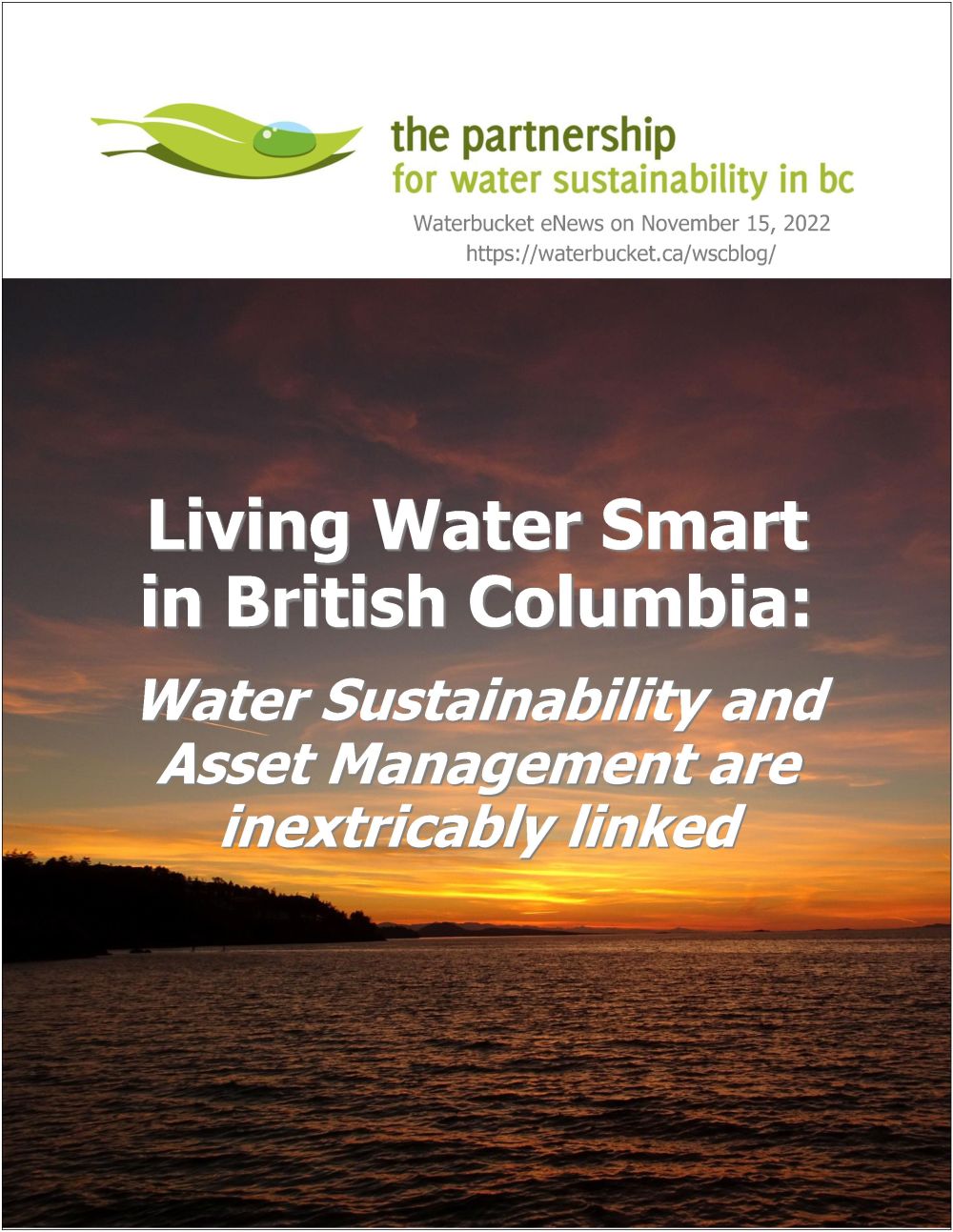AFFORDABLE AND SUSTAINABLE RE-INVESTMENT IN MUNICIPAL INFRASTRUCTURE IS ESSENTIAL: “The risk and consequences of not taking action for infrastructure renewal are substantially higher and more consequential than for Master Plans which are ‘futures’ documents,” stated Wally Wells of Asset Management BC
Note to Reader:
Waterbucket eNews celebrates the leadership of individuals and organizations who are guided by the Living Water Smart vision. The edition published on November 15, 2022 honoured Wally Wells, the founding Executive Director of Asset Management BC. Over the past decade, alignment of missions has been key to elevating Water Sustainability and Asset Management as top-of-mind priorities for local governments.
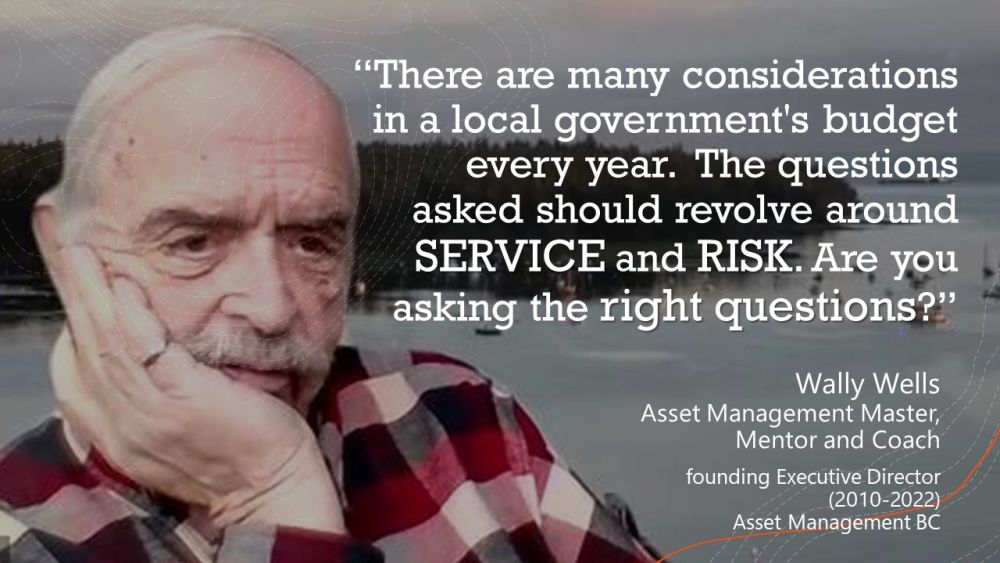
Water Sustainability and Asset Management are inextricably linked
In the “story behind the story” part of this article, we present an essay that is structured in two parts. Wally Wells of Asset Management BC is the thread that interweaves between the two parts.
In the first decade of the 2000s, Wally Wells was one of four champions whose combined efforts drove creation of “municipal asset management” in Canada. Two weeks ago, his peers honoured Wally Wells with the inaugural Asset Management Champion of BC Award.
Top-of-mind priorities for local government:
Our “story behind the story” spotlight is on what is achievable in the local government setting when individuals and organisations commit to a shared vision and mission, truly collaborate in good faith, and align their efforts for the common good. The term “setting” envelops both the local government and stream stewardship sectors. Through his actions, Wally Wells bridges the two.
Over the past decade, alignment of missions has been key to elevating Water Sustainability and Asset Management as top-of-mind priorities for local governments. The two priorities are inextricably linked, and the work of Asset Management BC and the Partnership for Water Sustainability is complementary in facilitating peer-to-peer learning across boundaries.
![]()
THE “FAB FOUR” HISTORIC STORYTELLERS > Four icons of asset management in Canada (from right to left) are Konrad Siu, Reg Andres, Guy Felio and Wally Wells. At the Asset Management BC Conference this month, they shared their Aha Moments and reflections on the history and future, respectively, of asset management in Canada. Their storytelling was streamed live across the country by the Federation of Canadian Municipalities (FCM).
Context for “the story behind the story”
Wally Wells is the founding Executive Director of Asset Management BC. He served in that role from 2010 through 2022. Wally is passing the baton. Thus, his intergenerational role going forward is framed as Asset Management Master, Mentor and Coach.
In 2017, Wally Wells connected the Partnership for Sustainability with NALT, which is the acronym for the Nanaimo & Area Land Trust. Wally did this because he is a NALT Director. His inciting action instigated what has evolved into Watershed Moments, the Vancouver Island Symposia Series on Water Stewardship in a Changing Climate.
Chaired by Paul Chapman who is the NALT Executive Director, the interagency Watershed Moments team is working towards Water Reconciliation. The pathway to get there is via Michael Blackstock’s Blue Ecology. This is a water-first approach to interweaving of Indigenous knowledge and Western science.
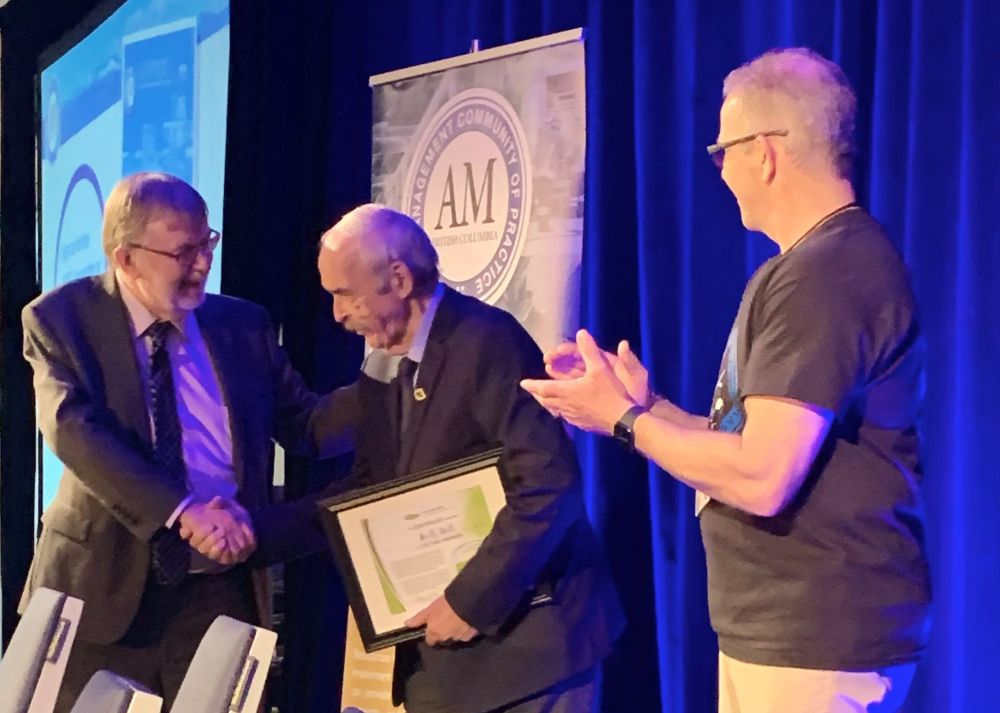
Recognition of Wally Wells (centre) of as a Lifetime Member of the Partnership for Water Sustainability. The presentation by Kim Stephens (left) took place at the Asset Management BC Conference held in Richmond on November 2nd.
EDITOR’S PERSPECTIVE / CONTEXT FOR BUSY READER
“A conversation with Wally Wells is always fun. He is enthusiastic and passionate about municipal asset management and associated implications for ‘quality of community’. Wally draws on many, many decades of experience to put engineering practices in context,” stated Kim Stephens, Waterbucket eNews Editor and Partnership Executive Director.
“As an advocate for Asset Management for Sustainable Service Delivery: A BC Framework, Wally Wells has done a public service by drawing attention to the urgent need to engage and inform elected representatives so that they truly understand ‘risks and consequences’ associated with their core responsibility, infrastructure.
“Wally Wells is tireless in urging local governments to wholeheartedly embrace and get on with implementing a strategy for affordable and sustainable re-investment in municipal infrastructure. ‘An asset management ‘plan’ deals with the risk and consequences for the community of doing or not doing what is necessary and essential,’ says Wally Wells.“

RISKS & CONSEQUENCES: What does Wally Wells say?
“For decades, we have trained our elected officials to understand the decision process and flexibility available for them when presented with Master Plans relating to land use and infrastructure servicing. Outside of accommodating growth, there are often few consequences and little risk in doing or not doing the suggested activities,” explains Welly Wells.
“For an Asset Management Plan, though, decisions do have risks and consequences. An Asset Management Plan is about what is necessary to continue providing EXISTING services at existing levels, Thus, a decision not to invest in infrastructure renewal would risk reducing or compromising EXISTING levels of service.”

“Asset Management, itself, is an awkward term which was coined by the Australians about two decades ago. We have managed assets for decades and understand what that is and what we are doing. Suddenly we took two very simple words, reversed them, and went from managing assets to asset management. The result? We confused everyone.”
“Section 7 of the Community Charter defines the roles and responsibilities of local government in terms of “care of infrastructure and services”. In other words, Sustainable Service Delivery. This goes to the heart of affordable and sustainable re-investment in municipal infrastructure assets to meet a level-of-service desired by the community,” concludes Wally Wells.
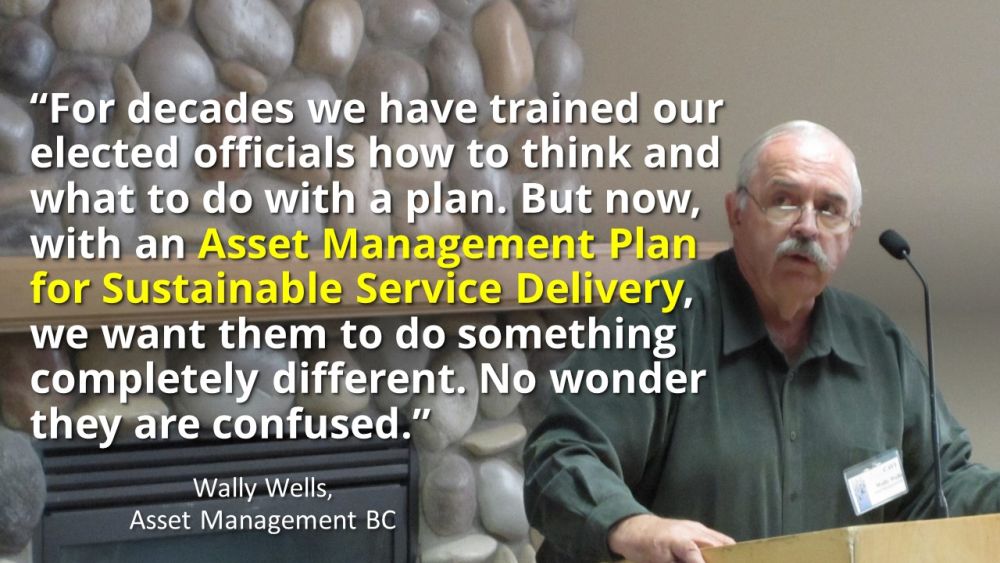
STORY BEHIND THE STORY: Reflections on sharing a mission with Wally Wells
Good ideas that lead to action invariably start with a conversation. This is the context for the 2-part essay that follows. Listening is a foundation piece for reaching consensus. When there is trust and respect, anything is possible. That is the takeaway message.
In Part One, we delve into how the relationship between Wally Wells and the Partnership for Water Sustainability had its start. This sets the stage for Part Two which is about the pathway to Water Reconciliation.
What we are essentially talking about in Part Two is going back to the headwaters of where we got our relationships with water and with one another wrong; and then starting back down the river of time – this time together – with a full understanding of the importance of embracing a water-first approach to planning human interventions in the environment.
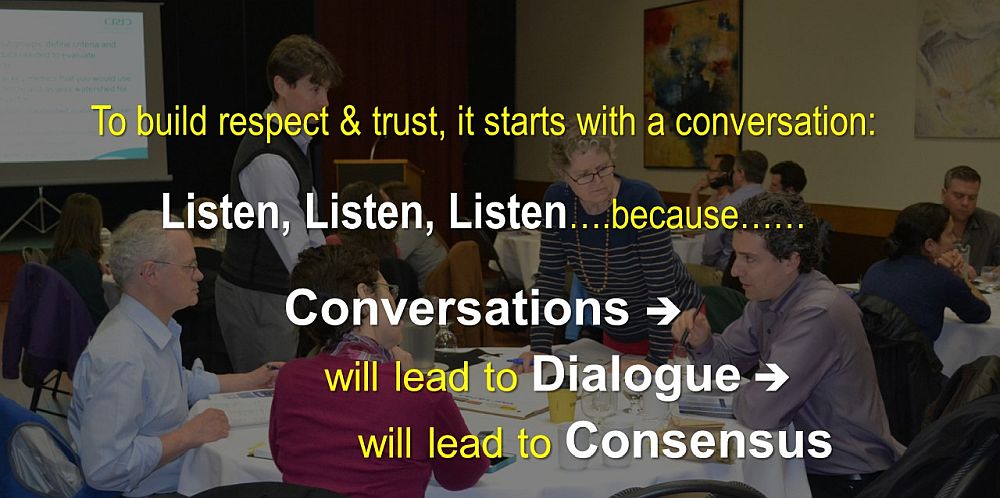
PART ONE – Water Sustainability and Asset Management (reflections by Kim Stephens)
Two moments define my collaboration with Wally Wells. The first was my introduction to Wally in September 2010. The second was an email from Wally in March 2017.
Looking back, both were game-changing moments in what evolved into a shared vision for a whole-system approach to operationalizing Sustainable Service Delivery. The essence of the whole-system approach is that constructed and natural systems both provide municipal services.
Alignment of efforts with Wally has been key to elevating Water Sustainability and Asset Management as top-of-mind priorities for local governments. The two priorities are inextricably linked, and our efforts are complementary in facilitating peer-to-peer learning across boundaries.
Flashback to 2010
The Partnership was the established group and Asset Management BC was newly formed. Glen Brown was central to both. Under Glen’s leadership as our Chair (2008-2010), the Partnership morphed from an inter-governmental partnership into a stand-alone legal entity. This assured continuity in delivering the Water Sustainability Action Plan, released in 2004.
In parallel, Glen convened an Asset Management Community-of-Practice, with Wally Wells as his volunteer extraordinaire. Wally was a recent arrival to British Columbia. Although he had just retired from his day job in Ontario, his mission was not over. Wally became hands-on with Asset Management BC.

|
|
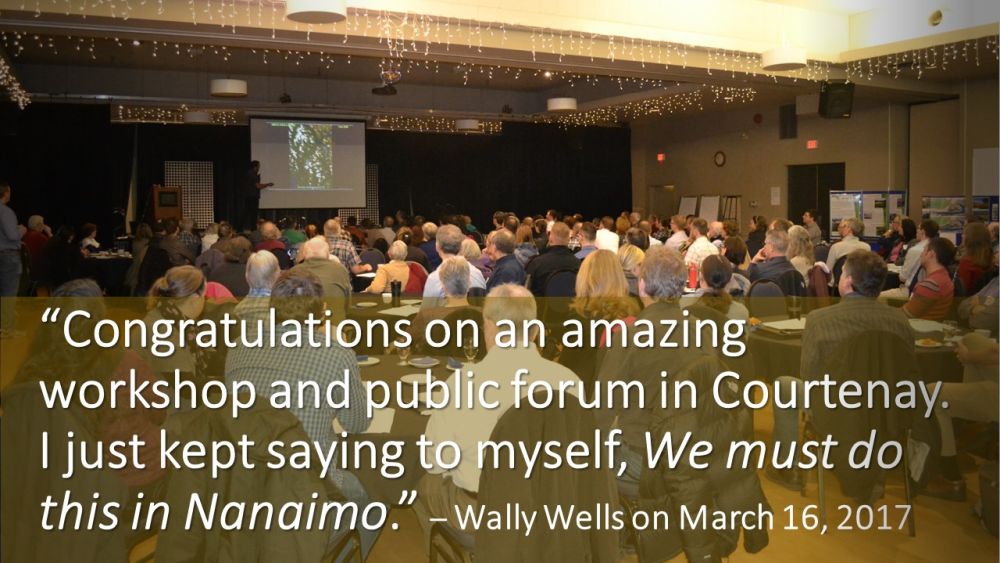
|
|
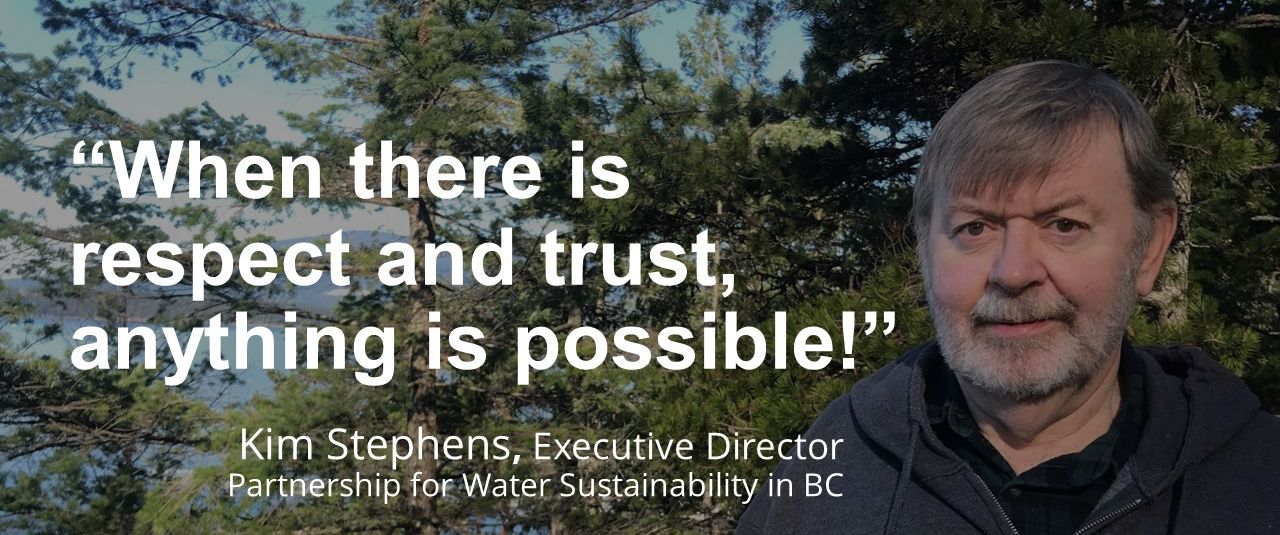
PART TWO – Blue Ecology is a pathway to Water Reconciliation (reflections by Paul Chapman)
Wally Wells brought his enthusiasm for the Courtenay Eco-Asset Symposium to the Nanaimo & Area Land Trust (NALT) boardroom. He began to connect the dots for us between asset management and ecology. The meeting over coffee, with members of the Partnership for Water Sustainability in BC, set us on the route we continue to follow today.

The Symposia Series
Beginning in Nanaimo in 2018, the idea for what has now become the Watershed Moments Symposia Series, started as a modest idea to highlight the successes and challenges of water stewardship in the Nanaimo area. This meeting brought together service providers, regulators and stewardship groups and began the nascent discussion of our common interests in water stewardship.
Our discussions led to an expanded common vocabulary. Sustainable Service Delivery, Eco-Assets and Eco-Asset Management, the Ecological Accounting Process, Riparian Deficit, Municipal Natural Asset Inventory, and watershed stewardship are some of the words in our new common tongue. The rabid environmentalist, the cold-hearted accountant and the aloof engineer could come together and focus on a common goal – Water Balance.
Our understanding of “water balance” has grown beyond the graphics of how water travels across a landscape, is absorbed or taken up to be distributed again. Water balance at a very key level is about our relationship with water and with each other. We design and build our communities based on our relationship to water. Our neighbourhoods arise from this relationship. Resilient communities will embrace the language and lessons of Sustainable Service Delivery and Eco-Asset Management.
Budgets can be aligned with best practices, ecological know-how and boots in the stream to steward the critical infrastructure that is our watersheds.
Our understanding of water balance as a point to build relationships continues to grow
The senior stewards on the land, the Indigenous Peoples that have been actively and sustainably managing these eco-assets from the earliest memories have been shut out of the conversation and decision making for too long. Real water balance is about water reconciliation – recognizing our common ground in the watersheds, and interweaving our knowledge and experience. This is the Blue Ecology path.
For NALT, Wally Wells brought us on this journey. He helped us expand our discourse and our understanding of alignment across sectors and stewardship roles.
We’ve always been in this together, now we know it too.
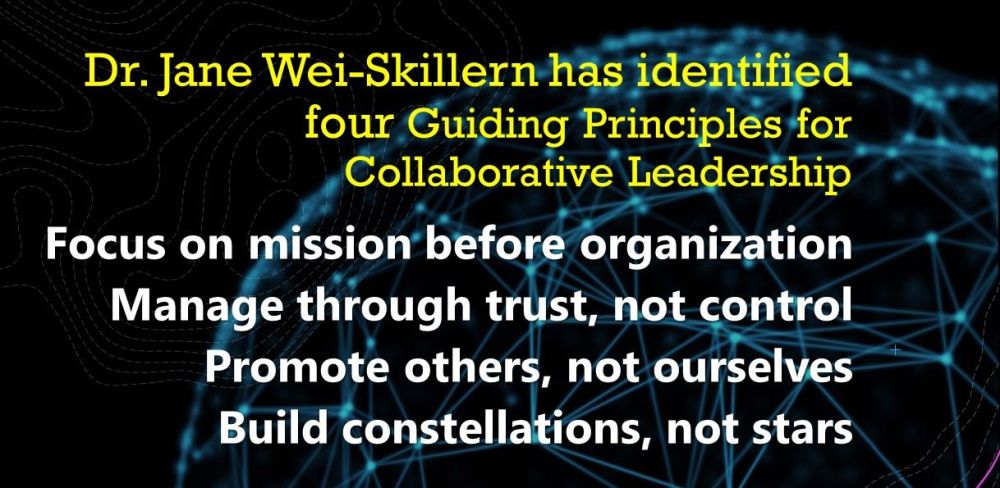
Did you enjoy this article? Would you like a PDF document version? Click on the image below to download your copy.
DOWNLOAD A COPY: https://waterbucket.ca/wcp/wp-content/uploads/sites/6/2022/11/PWSBC_Living-Water-Smart_asset-management-water-sustainability_2022.pdf


